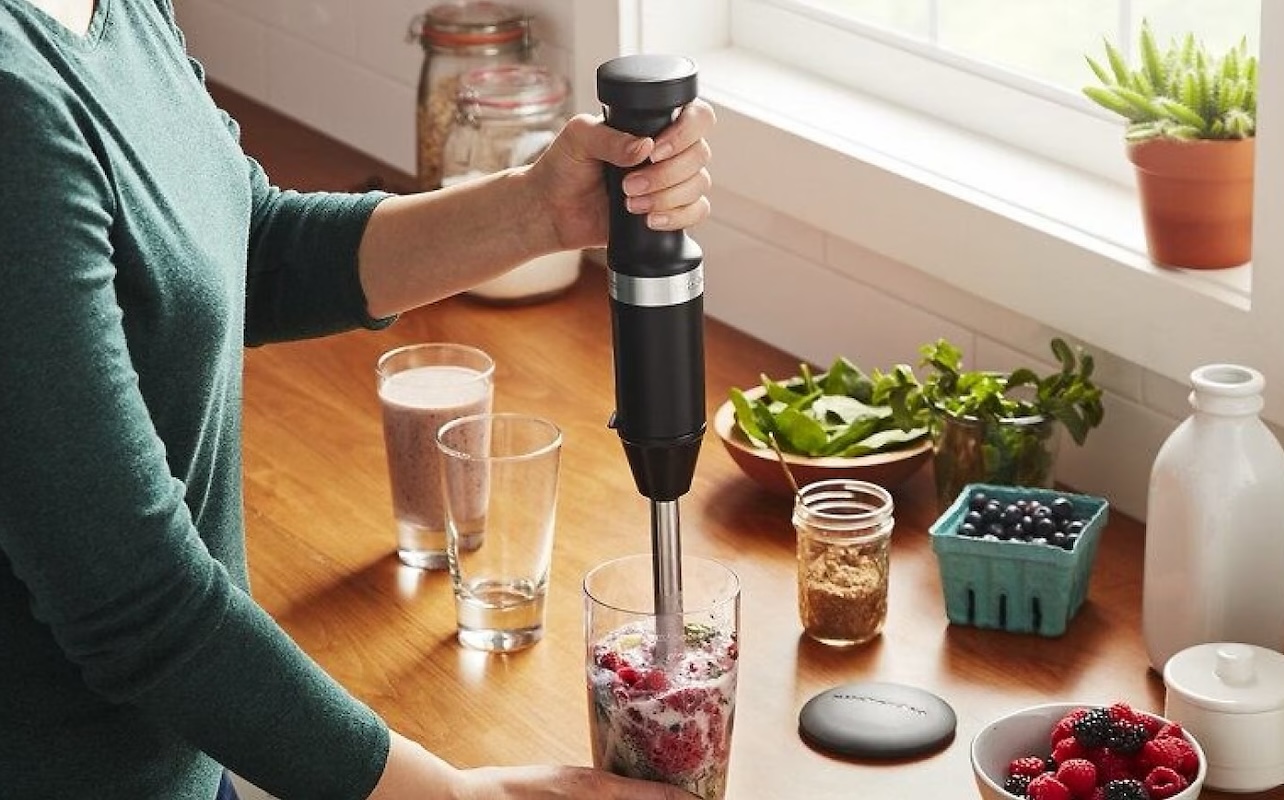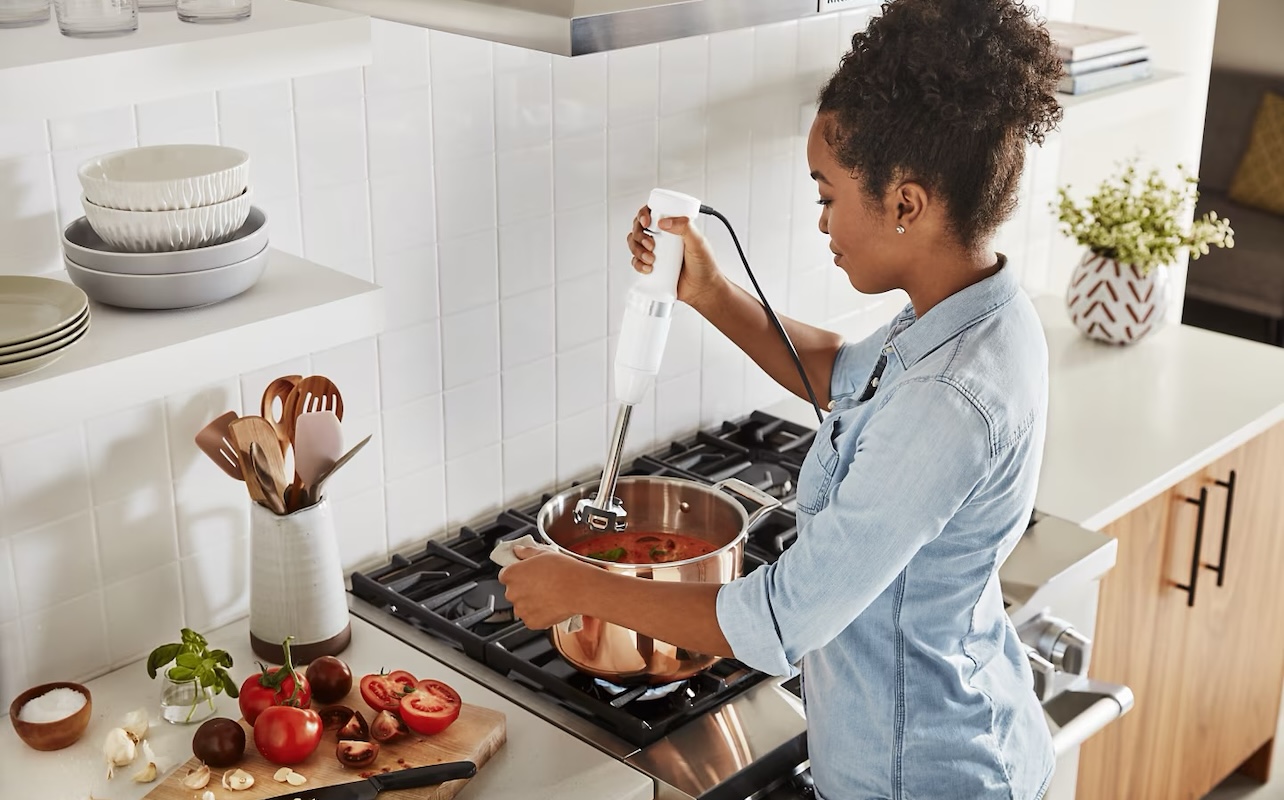
Choosing between a hand mixer vs immersion blender? You’re not alone. Both are compact, motorized, and built to make kitchen life easier. They look similar; however, they do completely different jobs. A hand mixer is your go-to for whipping, beating, and mixing, while an immersion blender (also called a stick blender) is built to puree, blend, and emulsify. Think of it this way: one of these is a baker’s best friend, and the other is a chef’s.
In this guide, we’ll break down what each appliance does, what they’re best for, their pros and cons, and how to choose the right one based on how you cook.
What is a hand mixer?
A hand mixer is a small but mighty kitchen helper that shines when it comes to baking. It’s a handheld electric appliance with two beaters that rotate to mix ingredients quickly and efficiently. Hand mixers are perfect for whipping cream to dreamy peaks, beating eggs for fluffy omelettes, mixing cake batter and cookie dough, and kneading light bread or pizza dough, especially with dough hook attachments. Note that many consumer-grade hand mixers struggle with heavier doughs.
Many hand mixers come with extended features so you can use them to tackle even more kitchen tasks. Look for mixers with multiple speed settings, cordless options, and interchangeable attachments like dough hooks or whisks to get even more out of your mixer.
If your kitchen is your personal bake shop, a hand mixer is almost non-negotiable.
What is an immersion blender?
An immersion blender—also called a hand blender or a stick blender—is your go-to tool for transforming chunky ingredients into smooth purées. They’re great for blending without needing to transfer your ingredients into a specific container. Use your immersion blender to purée rich, creamy soups right in the pot (no hot liquid transfers required!) and blend sauces like tomato or béchamel to perfection. Or, use your immersion blender to make smoothies or milkshakes straight in your glass, whip up baby food, or emulsify salad dressings.
Most immersion blenders feature a detachable blending arm with an inset, double-sided blade. Their slim, space-saving design fits neatly in a drawer, and optional attachments like a whisk or mini chopper add extra versatility. In immersion blenders where the blending wand is detachable from the motor, the blending wand and blade are typically dishwasher-safe.
If you’re more into cooking than baking—or you love a good butternut squash soup or green smoothie—this an immersion blender might just be your kitchen MVP.
Key differences between hand mixers vs immersion blenders

What sets an immersion blender and hand mixer apart? While they may look alike, these tools play very different roles in your kitchen. Here’s how they stack up.
Functionality
Hand mixers are designed to mix. They’re all about combining ingredients evenly and incorporating air—beating eggs, whipping cream, or mixing cake batter. Reach for them to create light, fluffy textures or to mix (but not purée or blend) ingredients. Immersion blender are made for blending and puréeing. They’re the tool to reach for when you want smooth soups, emulsified sauces, or creamy smoothies.
Design and attachments
Hand mixers typically come with beaters; occasionally, you can attach dough hooks or whisks to them, too. Their attachments are designed to spin in a circular motion to aerate and mix. Immersion blenders use an inset blade at the end of a long stick. Some models may also work with attachments like a whisk or mini chopper, adding a layer of versatility.
Food types and textures
Hand mixers shine with thicker, chunkier mixtures—cookie dough, cake batter, icing, mashed potatoes, and whipped cream. Immersion blenders handle liquid-based recipes like tomato soup, pesto, hollandaise sauce, or hummus, creating a smooth, silky finish.
Cleaning and storage
Cleaning a hand mixer usually means removing the beaters and wiping down the motor body. The mixer’s attachments are usually dishwasher-safe. But there’s more to store when compared with an immersion hand blender. Immersion blenders are ultra-compact, with a detachable wand that’s easy to rinse and is generally dishwasher-safe. They’re typically longer than a hand mixer, but more compact overall.
Versatility
Hand mixers are baking workhorses. If cakes and cookies toppings are your jam, they’re hard to beat—hand mixers are perfect for creaming together butter and sugar. They’re also great for making toppings like icing and whipped cream. Immersion blenders, on the other hand, are the kitchen ninjas of the blending world. With the right attachments, they can chop herbs, whip cream, and even replace a mini food processor.
Hand mixer and immersion blender: Pros and cons

Here’s a quick rundown of each tool’s strengths and limitations to help you out.
Hand mixer
Pros
- Perfect for baking tasks like whipping, beating, and mixing
- Lightweight and easy to use
- Often more affordable than a stand mixer
- Some can tackle light dough with dough hooks
Cons
- Not suitable for blending hot liquids or pureeing
- Many takes up more space than an immersion blender
- Limited in use outside of baking tasks
- Can’t be used to make chunky incredients smooth
Immersion blender
Pros
- Blends soups and sauces directly in the pot for less mess
- Great for smoothies, baby food, and dressings
- Compact and easy to clean
- Can replace a full-size blender for many small tasks
Cons
- Not meant for thick or dry mixtures like cookie dough
- Less effective for whipping or incorporating air into mixtures
- May struggle with very hard ingredients like ice or nuts (unless you get a high-powered model)
Which one should you buy?

When you’re looking at hand mixers vs immersion blenders, which tool deserves a spot in your kitchen? It all comes down to what you love to make, how often you cook or bake, and the kind of convenience you’re after.
Choose a hand mixer if:
- You love baking or frequently whip cream, beat eggs, or mix dough. Whip up fluffy chocolate chip pancakes with perfectly beaten eggs and soft peaks of whipped cream. Craving fresh-baked cookies? Your hand mixer makes creaming butter and sugar a breeze. Cinnamon rolls? Dough hook attachments can help you knead soft dough without breaking a sweat.
- You want a lightweight, affordable alternative to a stand mixer. If you’re not quite ready to splurge on a stand mixer, a good hand mixer can handle many of the same tasks without hogging your counter space or budget. It’s perfect for small-batch bakers or anyone just starting out. Great for apartment living, college students, or gifting to the aspiring baker in your life.
- Your recipes involve dry or semi-solid ingredients. Think cookie dough, banana bread batter, frosting, mashed potatoes—even cheesy garlic biscuit dough. A hand mixer can power through these mixtures easily and evenly, saving you time and sore arms from hand-mixing.
Choose an immersion blender if:
- You often make soups, sauces, or smoothies. Imagine blending a creamy roasted tomato basil soup right in the pot—no awkward ladling into a blender and risking spills. Or a smooth, rich butternut squash soup topped with a swirl of coconut milk. You can also blend smoothies directly in your glass: try frozen mango, spinach, and oat milk for a quick, nutrient-packed breakfast.
- You want a quick, easy tool for blending directly in the pot or cup. Less mess, fewer dishes. Whether you’re emulsifying a vinaigrette, whipping up a garlic aioli, or blitzing a post-workout shake, immersion blenders keep things simple. No transferring back and forth between containers; just blend and go.
- You have limited storage and want something versatile. Live in a condo, dorm, or tiny home? An immersion blender is a minimalist’s dream. It fits in a drawer, comes apart for easy cleaning, and many models include extra attachments like whisks or mini choppers that can replace bulkier appliances.
Do you need both a hand mixer and an immersion blender?
Many kitchens benefit from having both. Start with the one that suits your current cooking habits, and add the other down the line when your culinary skills (and cravings) expand.
The right tool depends on what—and how—you cook
No matter what you choose, one thing’s for sure: making your next meal (or dessert!) just got a whole lot easier. If you’re a home baker who dreams in cupcakes and icing, the hand mixer is your best friend. If you’re more of a soup whisperer or smoothie lover, the immersion blender is a great culinary companion. And if you’re both? Lucky you—get both tools and unlock the full potential of your culinary creativity.
Ready to make your pick? Check out Best Buy Canada for a full selection of hand mixers and immersion blenders to find the one that fits your kitchen style—and your cooking vibe.
This article was drafted using AI technology and then reviewed, fact-checked, and revised by a member of our editorial team.





